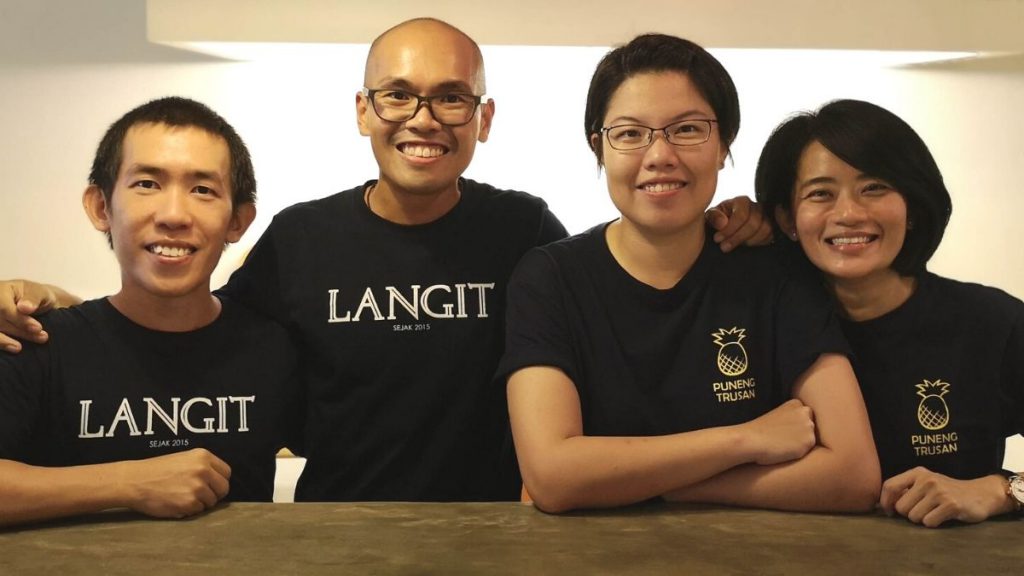If I were to ask you right now to point out where each raw ingredient in your refrigerator or pantry came from, would you be able to answer?
Would you know who planted it or when it was harvested?
This is exactly what Langit Collective (Langit), a food supplier, wants to change with traceable technology for their rice called Foodprints.
But why does this matter?
The Impact Of A Story
“Foodprints started off as an internal need to have baseline data points that reflected the various rice that’s grown by our respective farmer-partners, production data like yield per plot, farming practices, etc.,” Melisa, Langit’s co-founder told us.
“Our farmers grow rice in a traditional manner, a big contrast to the industrialised paddy farming industry, and we realised that the general public doesn’t know much about this alternative perspective,” she added.
Through their mapping and data collection effort, they recognised the importance of these stories being told in an accurate manner.
“For Langit, every product we sell creates a direct economic impact to the farmers we serve,” Melisa said.
“It is crucial for us to illustrate to the customers that a simple purchasing decision can contribute to a greater goal beyond providing nutritious food to themselves or their families.”
Aside from accomplishing that, Foodprints also serves as Langit’s brand guarantee for bringing good quality and authentic products to the market.
Retracing A Product’s “Foodprints”
“For a user, it’s a very simple process,” Melisa said.
Langit sells their rice in brick-shaped packets, and in the corner of each brick is a sticker with a unique QR code.
Once the QR code is scanned, users will be able to see basic information like the farmer’s ID (face and name), the rice variety, milling date, and origin.

“The farmers’ expanded stories are still in the works and we should see more comprehensive stories being shared by Q1 in 2021,” Melisa said.
They’ll also be using IoT (the internet of things) to collect field data and add more information, such as the nutritional value of rice and the store the customer purchased the rice from.
If you’re curious to see what Foodprints currently looks like but don’t have a Langit product to scan, you can head to the Foodprints website and key in bf63e696 for the ID.
3 Years & RM300k Later
With help from friends who lent them a drone, Foodprints was created by Chia Yong Ling, the CTO and co-founder of Langit.
It took 3 years because the groundwork behind this system entailed multiple methods of data collection from interviewing farmers and drone mapping, for example.

In total, an estimated amount of RM300,000 has been invested in developing Foodprints, particularly for all the arduous processes it took to acquire the necessary data.
During those 3 years, its development was also kept a tight secret. As for why, Melisa joked, “To stay away from the copycats…”
Answering more seriously, she said that they simply didn’t want to attract any unnecessary attention that might’ve affected their work on the ground.
Unsecured data could fall into the wrong hands, which can be detrimental to the community they serve.
“We are a pretty conservative bunch, hence it makes sense for us to share something that works rather than an unproven concept. For us, getting it right is more important than getting it fast,” Melisa stated.
Targeting The Right Market
To me, unless you were already a Langit customer or had some interest in environmental sustainability or social impact, you may not find much value in Foodprints.
Melisa agreed, saying, “The first group of people who will appreciate Foodprints are definitely our existing customers as they remain to be our greatest supporters, and they have seen how we grow as a brand and organisation.”
However, they’re also seeing a growing interest amongst Malaysians to understand where their food comes from and how it’s grown.
“Whilst adoption or interest may be slow in the beginning, it is work that needs to be done,” Melisa stated.
Their cause with Foodprints is noble, though I wondered if it was meant to boost the marketability of Langit’s products too, especially for those new to socially impactful purchasing.
“Yes,” Melisa said, “But we believe the marketability contribution would kick in progressively, perhaps a more mid to long-term outcome.”
The more immediate outcome we expect to see is for it to serve as a clear market differentiator from other rice products, birth the idea of how traceability can look like, and as an awareness tool to create conversations surrounding the authenticity of our food, the human connection with our food producers, and food integrity.
Melisa Lim, co-founder of Langit Collective
- Learn more about Langit Collective here and Foodprints here.
- You can read about other Malaysian startups we’ve written about here.
Featured Image Credit: Langit Collective












